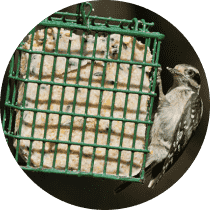Bewick's Wren
A species of Bewick'S Wrens Scientific name : Thryomanes bewickii Genus : Bewick'S Wrens
Bewick's Wren, A species of Bewick'S Wrens
Botanical name: Thryomanes bewickii
Genus: Bewick'S Wrens
Content
Description People often ask General Info
Description
The Bewick's wren has an average length of 5.1 inches (13 cm) an average weight of 0.3 to 0.4 ounces (8 -12 g), and a wingspan of 18 cm. Its plumage is brown on top and light grey underneath, with a white stripe above each eye. Its beak is long, slender, and slightly curved. Its most distinctive feature is its long tail with black bars and white corners. It moves its tail around frequently, making this feature even more obvious for observers. Juveniles look similar to adults, with only a few key differences. Their beaks are usually shorter and stockier. In addition, their underbelly might feature some faint speckling. Males and females are very similar in appearance. 
Size
13 cm
Colors
Brown
Gray
White
Life Expectancy
8 years
Nest Placement
Cavity
Clutch Size
3 - 8 eggs
Incubation Period
1 - 3 broods
Number of Broods
14 - 16 days
Nestling Period
14 - 16 days
Feeding Habits
Bewick's Wren consumes insects, eggs, larvae, pupae, and adults of invertebrates. They feed on bugs, beetles, bees, wasps, caterpillars, butterflies, moths, grasshoppers, crickets, flies, spiders, and also eat seeds, fruits, pebbles, and mud. They glean prey from vegetation below 3 meters or the ground and can forage upside down. Nestlings are fed caterpillars, spiders, and grasshoppers. Bewick's Wren wipes its beak post-feeding and eats suet, peanut hearts, sunflower seeds, and mealworms at feeders, especially in winter.
Habitat
Bewick's Wren thrives in open woodlands and chaparral, often inhabiting brushy, scrubby regions such as hillsides and dry uplands. They prefer environments with a blend of dense shrubbery and open spaces, which include habitats like oak woodlands, desert scrubs, and mixed evergreen forests. Bewick's Wren is typically found at lower altitudes in a variety of climates, adapting to live among cacti, mesquite, and suburban plantings. This species is especially common in drier areas of the Southwest and is more prevalent in these environments than in wetlands or dense forests.
Nest Behavior
The male bewick's Wren begins nest construction and the female assists, with the process taking under 8 days, though sometimes weeks. They lay eggs soon after, sharing incubation and chick-rearing, demonstrating strong parental care.
Nest Characteristics
Bewick's Wren's nests are typically found in cavities or on sheltered ledges, up to 30 feet high. They build with sticks, grasses, rootlets, and other plant materials, and may include spider egg cases. The open cup-shaped nests are often lined with feathers, hair, or wool, and uniquely feature snakeskin linings. Nests measure 2.5-3 inches in height and 4-5 inches across, with cups 1-2 inches deep.
Dite type
Insectivorous
People often ask
General Info
Feeding Habits
Bird food type

Hulled Sunflower Seeds

Suet

Peanut Hearts

Mealworms
Bird Feeder Type

Large Tube Feeder

Suet Cage

Large Hopper

Small Hopper

Platform

Ground
Sounds
Call
Recording location: Mexico
Song
Recording location: Mexico
Call
Recording location: United States
Song
Recording location: United States
Behavior
Bewick's Wren exhibit remarkable agility, frequently seen gleaning insects and arachnids from various plant surfaces, often conducting their search upside down. Their foraging is primarily within 10 feet of the ground, utilizing a blend of pecking and hopping maneuvers. They uniquely employ bill-wiping post-consuming their prey, engaging in repeated bill cleaning against perches. Their flight is characterized by direct, swift movements. Male bewick's Wren are notably territorial, using their songs as a defense mechanism against intruders, and may engage in chases when contested, generally losing to House Wrens. Courtship behaviors include food offerings and tail displays, and their characteristic tail wagging is a distinct sign of the species.
Distribution Area
The Bewick's wren once had a range that extended throughout much of the United States and Mexico and parts of Canada. It used to be fairly common in the Midwest and in the Appalachian Mountains, but it is now extremely rare east of the Mississippi River. It is still found along the Pacific Coast from Baja California to British Columbia, in Mexico, and in a significant portion of the Southwest, including Texas, Arizona, New Mexico, and Oklahoma. Western populations do not tend to migrate. Eastern populations, prior to their decline, used to migrate from its northern range to the Gulf Coast. The preferred habitat of the Bewick's wren is that of arid open woodlands and brush-filled areas such as hillsides and uplands, but will reside in humid areas locally (Subtropical and Temperate zones). They are more common than house wrens in drier habitats, such as those found in the Southwest. In California, Bewick's wrens inhabit a shrubland area called chaparral. 
Species Status
In 2016, the Bewick's wren was listed as least concern on the IUCN Red List of threatened species due to the size of its range and estimates of its population size. However, ornithologists have noted a severe decline in its eastern range and parts of its western range. In particular, it has virtually disappeared from east of the Mississippi. In 1984, the state of Maryland classified the Bewick's wren as endangered under its Maryland Endangered Species Act of 1971. 
Scientific Classification
Phylum
Chordates Class
Birds Order
Perching birds Family
Wrens Genus
Bewick'S Wrens Species
Bewick's Wren 